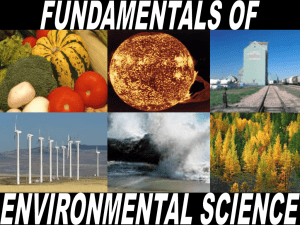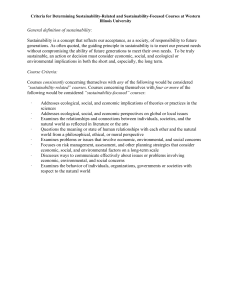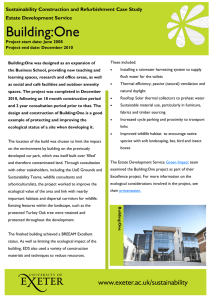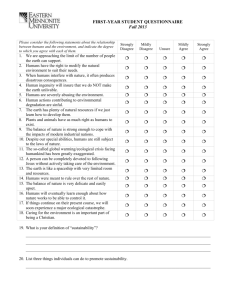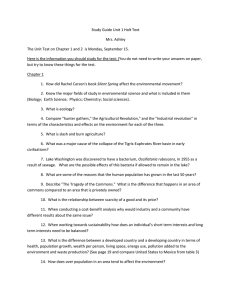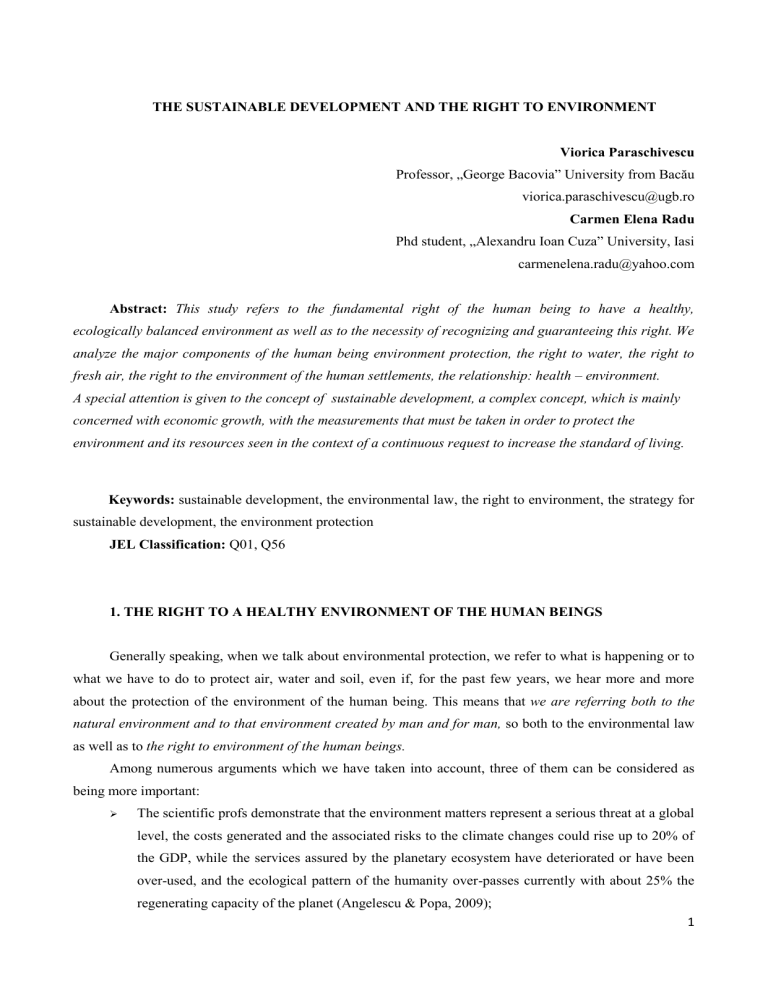
THE SUSTAINABLE DEVELOPMENT AND THE RIGHT TO ENVIRONMENT Viorica Paraschivescu Professor, „George Bacovia” University from Bacău viorica.paraschivescu@ugb.ro Carmen Elena Radu Phd student, „Alexandru Ioan Cuza” University, Iasi carmenelena.radu@yahoo.com Abstract: This study refers to the fundamental right of the human being to have a healthy, ecologically balanced environment as well as to the necessity of recognizing and guaranteeing this right. We analyze the major components of the human being environment protection, the right to water, the right to fresh air, the right to the environment of the human settlements, the relationship: health – environment. A special attention is given to the concept of sustainable development, a complex concept, which is mainly concerned with economic growth, with the measurements that must be taken in order to protect the environment and its resources seen in the context of a continuous request to increase the standard of living. Keywords: sustainable development, the environmental law, the right to environment, the strategy for sustainable development, the environment protection JEL Classification: Q01, Q56 1. THE RIGHT TO A HEALTHY ENVIRONMENT OF THE HUMAN BEINGS Generally speaking, when we talk about environmental protection, we refer to what is happening or to what we have to do to protect air, water and soil, even if, for the past few years, we hear more and more about the protection of the environment of the human being. This means that we are referring both to the natural environment and to that environment created by man and for man, so both to the environmental law as well as to the right to environment of the human beings. Among numerous arguments which we have taken into account, three of them can be considered as being more important: The scientific profs demonstrate that the environment matters represent a serious threat at a global level, the costs generated and the associated risks to the climate changes could rise up to 20% of the GDP, while the services assured by the planetary ecosystem have deteriorated or have been over-used, and the ecological pattern of the humanity over-passes currently with about 25% the regenerating capacity of the planet (Angelescu & Popa, 2009); 1 The reason for which the UNO has declared the year 2010 The International Year of the Biodiversity is the decline of the ecosystems. An alert-report presented by the UNO illustrates the devastating state of the present-day environment; The world populations ignore the notion of sustainable development and the sense of the theme of the 21 Agenda. Today, the humankind faces the Ecologic Revolution, dictated not by technological discoveries but by a survival instinct. The earth is not” a business in liquidation”. “For the first time a civilization uses the capital of nature instead of living from the interests given by this capital”, said Toffler. The specialists think that the time we have left is about 10-15 years in order to take the right decisions whose results cannot be seen earlier than 50 years. Nowadays, we are dealing with the following major environment problems: Pollution (pollution, pollutants, sources of pollution, prevention, improvement) – thus the environmental protection is more and more necessary; The exhaustion of resources – the environmental conservation becomes increasingly necessary; Responsiveness (in agreement with the sustainable development and the corporate ecologism) – the ecologic education and the assuming of responsibility is more and more necessary for everyone. This is the true meaning of the sustainable development. Despite the importance of the environmental protection by people and for people, the concept of the fundamental human right to have a healthy, ecologically balanced environment and also the necessity of its acknowledgement and guarantee has crystallized and structured only in the second half of the twentieth century. The unsatisfactory results of various international meetings about environmental issues are primarily due to the disproportions between levels of development from different areas of the planet. On the other side, the ecological imbalance developed in time and got worse. A good proof is the international, regional and national concerns from the past twenty years. Even the names given to recent UN environment: conferences: in 1972 (Stockholm) – The UN Conference for Environment, in 1992 (Rio de Janeiro) – The UN Conference for Environment and Development, in 2002 (Johannesburg) – The UN Conference for a Sustainable Development. The international consecration of the right to environment was made through the Statement of the first UN Conference regarding the Environment from Stockholm, when it was proclaimed that:” Man has the fundamental right to freedom, equality and adequate conditions of life, in an environment of a quality that permits a life of dignity and well-being. He bears a solemn responsibility to protect and improve the environment for present and future generations”. This concept is held a few years later , as a guiding line, within the international relationships , through the World Charter for Nature(1982), and then within the first principle of the Declaration of Rio de Janeiro (1992): “Human beings are at the centre of concerns for sustainable development. They are entitled to a healthy and productive life in harmony with nature.” As a result, the international community has focused slowly and rather corrective its attention upon the aspects which had a visible effect, sometimes with serious consequences, the human beings and the spaces where 2 they operate, taking into consideration the following dimensions of this environmental component – the protection of the human being environment: The protection of the human settlements environment ; The environmental protection from hazardous and radioactive substances; The environmental protection of the agricultural areas; The environmental protection against vibrations and noises; The environmental protection against waste. Of course, all this components have an important contribution to ensuring the quality of life and human health and include: the right to biodiversity, the right to clean and sufficient water, the right to unpolluted air, the right to environmental beauty, to its wealth and resources, the right to information about the environmental conditions, the right to an ecological education, etc. All the international and national documents that refer to human rights or to the environmental protection also refer to the right to environment, for example: The Charter of the Human Rights, The Romanian Constitution, The Approving Law of OU 195/2005 regarding the environment protection (Art 5, 55, 59, 70, 82, 85, 91, 92), and The Water Law etc. The past few year’s decades shows that there are important relationships between environmental quality and protection issues (globally and locally) and issues such as economic development, human development, population growth, poverty, changes in political structures. 2. THE ENVIRONMENT AND THE SUSTAINABLE DEVELOPMENT Analysing the definitions for “environment” and “sustainable development” we will acknowledge the correctness of our observations regarding the importance of the two concepts, among which the last one is less discussed. Referring to the legal aspect, the environmental law defines the environment as: a sum of resources that must be protected against pollution and degradation composed of: air, water, soil, subsoil, flora, fauna, natural energy sources and habitable land, a total of resources to meet the human’s needs. ISO 14001:2004 defines the environment as being “the space in which an organization operates including air, water, soil, subsoil, natural resources, flora, fauna, human beings and the relations between them.” It is clear that in making the concept of sustainable development concrete, one has to take into account a number of practical elements and obstacles. There is little doubt that integrated approaches are required to support sustainable development. Therefore, a new research paradigm is needed that is better able to reflect the complexity and the multidimensional character of sustainable development.(Pim Martens,2010) Sustainable development is a complex idea that can neither be unequivocally described nor simply applied. There are scores of different definitions, but we shall restrict ourselves to the most frequently quoted, that of the Brundtland Commission (WCED, 1987): “Sustainable development is development which meets the needs of the present without compromising the ability of future generations to meet their own needs.” 3 The aim of sustainable social development is to influence the development of people and societies in such a way that justice, living conditions, and health play an important role. In sustainable ecological development the controlled use and protection of natural systems is the main focus of concern and the maintenance of our natural resources. In sustainable economic development, the focus is on the development of the economic infrastructure and on an efficient management of natural and social resources. Even the redefinition of sustainable development that focuses on human well being and the action of removing the separation between economy and society still has drawbacks. Sustainable development needs to be based on principles that would apply to all issues whether they are classified as environmental, social, and economic or any mix of the three. Haughton (1999) outlines five equity principles: (i) Futurity – inter-generational equity-the right to environment of all generations; (ii) Social justice – intra-generational equity; (iii) Cross-border responsibility – the right of every nation to environment; (iv) Procedural equity – people treated openly and fairly–and; (v) Inter-species equity – importance of biodiversity. 3. THE PROTECTION OF THE HUMAN SETTLEMENTS ENVIRONMENT The human settlements are spaces for housing, socio-political and cultural sites, economic objectives, areas for recreation or any other facilities where human beings are operating activities and where the interests of their maintaining and developing, prevail any other issues. (Oprean & Suciu, 2003). The concept of “city” is defined by Toynbee as “a settlement whose people can not produce, within its limits, all the food they need”- which implies the existence of some agricultural land whose products are supplied to the city. The issue of the human settlements environment protection is highly complex and permanently changed. The main topics that must be addressed in the relationship city- environmental protection are: Pollution; Water; Garbage, waste; Transports; The relationship Environment-Health. The increasing urbanization and the explosion of the industrial zones from the past few decades have imposed national strategies to harmonize the interests of the human beings with the ones linked to environment. The following aspects are taken into consideration: The responsibilities of agencies and administrative authorities referring to the creating and maintaining of a healthy living environment aligned with the socio-economic development of localities and in agreement with the development plans and urban planning (the placement of the 4 objectives and architectural lines, routes and traffic control, sanitation, sewage systems, waste storage stations, water treatment stations, rest and recreation facilities etc.) Creating an appropriate framework of rules ; Imposing rules of conduct relating to hygiene and public health. 4. THE ECOLOGICAL MOVEMENT According to experts, the three supporters of sustainable development are the environment, the economy and the society. The introduction and the acceptance of the concept of sustainable development were due to the emergence of “conflicts” between these supporters. There is, thus, an interdependence mannatural environment, an indissoluble unit with a complex and dynamic nature and with profound implications on the social-economic development that mankind began to understand. Failure to have the right to environment and to the environmental low has led to the development of the ecology movement. The development of the ecological movement has proved that there is a lot to do in order to maintain equilibrium of environment and to prevent a conflict between economy-ecology-society-technology. The ecological movement was born with Rachel Carson's Silent Spring, the book which is widely credited to have helped the launch of the ecological movement. The book documented detrimental effects of pesticides on the environment, particularly on birds. She also accused the chemical industry of spreading disinformation, and public officials of accepting industry claims uncritically. But she was only a pioneer. Now, the worldwide researchers agree that a new ecological world order is needed to be established. The events of recent years reflect this. Solving the conflicts with the environment is vital for the ecological movement. It implies a radical change in the policy making process, mainly because of communities’ distrust in public institutions and in the technical control structures. Both the ecologist movement and the politicians must necessarily take into account the local, social, cultural and economic requirements, otherwise they risk losing the consensus among population. Therefore, the unilateral decisions of the authorities are viewed with suspicion and may be considered illegitimate. Man is the cause of the environmental imbalance but also … the solution. The green consumer, the “eco” phenomenon in politics, in research and technology, in education, in tourism, in public administration, in management and marketing are evidences of increasing concerns about the right to environment. In order to get the expected result, the practice of a management with a serious impact upon the environmental education should focus on creating networks and strategic alliances among the parties involved: the one who produces the act of education in institutions, the one who distributes permanent environmental education and the one who finances the program. 5 5. TOWARD A STRATEGY FOR SUSTAINABLE DEVELOPMENT A Sustainable Development Strategy is a blueprint that provides strategic direction and a framework for action on addressing sustainability. It includes the priorities and plans of action to integrate sustainable development into the government’s policies, programs and operations, and to deliver sustainable development with its partner organizations and in the wider community. The need for local Sustainable Development Strategies has emerged out of concerns at the international level about unsustainable practices on a global level. For example, concerns that the world needs to undertake economic development whilst considering protection of the environment, was first raised in a high profile manner through the ‘Our Common Future’ Report published by the United Nations World Commission on Environment and Development (WCED) in 1987. Subsequently, the most significant international Summit that has given a call to action on sustainable development is the United Nations Earth Summit in Rio de Janeiro in 1992. More than 170 governments, including the UK, committed themselves for the first time to a sustainable future. World leaders agreed a global sustainability action plan called ‘Agenda 21’ which called for widespread participation and partnership working to develop local strategies and plans for implementing sustainability at the community level called Local Agenda 21 (LA 21). Such a document encourages local initiatives, partnerships, and the development of strategies to: address climate change and utilize clean energy; promote sustainable transport; address sustainable consumption and production; effective natural resource management; and tackle social exclusion and poor public health. Local authorities need a sound understanding of sustainable development to: Be more responsible in the resources that they use, to reduce waste and to save the Council money. Show leadership in environmental and energy management and to reduce CO emissions. Work with communities and partners organisations to improve the quality of life for their local 2 communities. Reduce environmental impacts. Balance and integrate social, economic and environmental components. Meet the needs of existing and future generations by taking a long-term view of the consequences and the impact on future generations. CONCLUSIONS The general environment protection and its economic, ecological, social and cultural function represent a preliminary condition for the approach of the main ecological challenges at the international level. The role of the environment in satisfying primary, vital needs is generally well-known, but the 6 concrete possibilities to interfere for modeling social processes in such way that they contribute to the harmonization of this relation are less obvious or hardly accepted. The right to environment must be respected, measured. “To measure means to understand, to understand means to get knowledge, to have knowledge means to have the power” (H.J. Harrington, 2000) The education and the training is the primary foundation of the sustainable development. In the analytical report for 2009 of the European Union’s Strategy for Sustainable Development it is encouraged the effort of the Member States to create a strategic approach regarding the exchange of knowledge and best practices in order to stimulate environmental education and sustainable development. (http//ec.europa.eu//education/more-information/doc/sustdev_en.pdf) REFERENCES Angelescu,C., Popa, C., (2009), Promovarea tehnologiilor de mediu, nepoluate şi creşterea economică, în Rev. Calitatea + acces la succes, nr. 5, p. 41-44; Dumitru C., Management şiMarketing Ecologic, O abordare strategică, Editura Tehnopress, Iasi, 2004 Gidding, S.B.., et al., (2002), Environment, economy and society;; fitting them together into sustainable development, J.Sustainable development, 10, p.187-196; Harrington, H.J., Harrington J.S., (2001), Management total in firma secolului 21, Editura Teora, Bucureşti; Langley, P., Mellor, M., (2002), Economy, Sustainability and Sites of Transformative Space, New Political Economy, 7 (1), p. 49 - 66; Martens, P., (2006) Sustainability: science or fiction? , Sustainability: Science, Practice & Policy,2(1):36– 41. Published online January 18, 2006, http://sspp.proquest.com/ archives/vol2iss1/communityessay. martens.html. Moscovici, S., (2004), Despre natură, Să gîndim ecologic, Editura Ştiinţa, Chişinău; Oprean, C., Suciu, O. Managementul calităţii mediului, Editura Academiei Române, Bucureşti, 2003. Paraschivescu, V., Radu, C., Dimensions of the sustainability science in the economic culture, Globalization and Higher Education in Economics and Business Administration, vol.IV, Editura Universitaţii Alexandru Ioan Cuza, Iaşi, 2010 Paraschivescu, V., (2009), Strategii de mediu. Conflictele dezvoltării durabile, Editura Tehnopress, Iaşi; Toffler, A., (2006), Avuţia în mişcare, Editura Antet, Bucureşti; Toynbee, A. 1970. Cities on the Move. London, Oxford University Press; Zaman, Gh., Gherasim, Z., (2007), Criterii şi principii ale dezvoltării durabile din punct de vedere al resurselor acesteia, Buletinul AGIR nr. 1, ianuarie-martie, p. 136 – 142; Agenţia Europeană de Mediu, (2009), Introducere în tehnologiile ecologice, http//eea.europa.eu. http//ec.europa.eu//education/more-information/doc/sustdev_en.pdf 7
